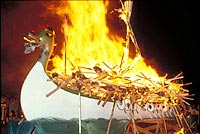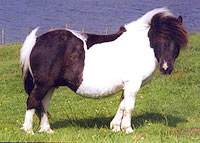About the Shetland Islands

Up Helly Aa fire festival
.
The Shetland Isles lie on the 60 degree north line of latitude. According to a local song, there are a hundred Shetland Islands that range from the biggest island – which we call the ‘Mainland’ – to tiny green holms you might spot in the distance. Of these hundred isles, just 16 are inhabited all year round.
And even though the islands are on the same latitude as St. Petersburg in Russia, Horseshoe in Alaska or Whitehorse in the Yukon Territory Canada the climate is mild – thanks to the Gulf Stream which warms our waters.
The Vikings came to Shetland in the ninth century and Norse rule prevailed for the next 600 years. Shetland only became a part of Scotland in 1469, and to this day Shetlanders are immensely proud of their Norse heritage manifested in the dialect, in place names, and the annual Up Helly Aa fire festival celebrations.
Within Shetland, some islands are linked to the Shetland Mainland by bridges. And ferries to the Northern isles, such as Yell, Unst and Fetlar run to a regular timetable, booking recommended. Some outlying islands also have a scheduled air service.
There is a network of 1,000 miles of high quality roads that are rarely busy – so you can take your time to enjoy the stunning views that await you at every twist and turn.

Picture by June Brown
Shetland has a population of about 23,000 people, approximately a third of those live in Lerwick, the main town.
With a coastline of almost 2,000 miles, there are countless beautiful beaches and an abundance of spectacular cliff scenery. In the breeding season (May-August) hundreds of thousands of seabirds make their homes at our shores, and you could find yourself within feet of our loveable puffins. Known ornithologist such as Bill Oddie and many others have come to Shetland to see our seabirds.
But there is also a good chance you might spot whales, dolphins and porpoises around our shores. And seals can be commonly seen on a short stroll around the outskirts of Lerwick, and sometimes even playing in the harbour.
Of course, Shetland Ponies are a must for every visitor. You’ll find many of those loveable windswept ambassadors to Shetland roaming the countryside. But if you’d like a closer look, your Shetland Guide will be able to arrange a visit to one of the stud farms where you can get an in-depth introduction to Shetland Ponies and meet them close-up. Remember that May is the foaling season!
As you roam the islands, you’re quite likely to see otters – indeed there are road signs that warn of “Otters Crossing” – so keep your eyes peeled!
You’ll also see the native, multi-coloured Shetland sheep which produce the very finest wool. The Shetland Museum and Archives have a fine display on traditional Shetland knitting – from the famous Fair Isle jumpers to the gossamer-fine lace reserved for Weddings and Christenings – that, amongst other exhibits, will give you a great view into life present and past on Shetland. Both traditional and modern knitwear designs are, of course, also for sale at a selection of local outlets.
On the island of Mousa a 2,000-year-old double walled stone tower or ‘Broch’ remains virtually intact and unique to archaeologists. Tiny, shy storm petrels nest in the walls of the Mousa Broch and can be seen during the ‘Simmer Dim’ – the Shetland summer twilight when it never really gets dark up here.
Other ancient Sites like the world-famous Jarlshof date from Neolithic times onwards and take you on a fascinating journey through time from the Stone Age to the period of the Scottish Lairds.
Or there is Old Scatness: our ‘living history project’, which chronicles another important multi-period archaeological site and gives you a ‘hands-on’ experience of life in the Wheelhouses and Brochs of the late Iron Age and beyond.
More recent history tells heroic stories of the ‘Shetland Bus’, an operation out of Shetland during World War II, and its vital contribution to the Norwegian resistance.
Shetlanders can certainly look back on a colourful and varied past. But in recent years they have enjoyed a prosperous and buoyant economy with near full employment. Fishing, aquaculture, agriculture, the oil industry and tourism all play their part, as well as homegrown products such as the world famous Fair Isle knitwear and delicious local produce such as salmon, lamb and mussels.
Our Islands have always moved with the times and today Shetland is a delightful blend of old and new. In our many schools children learn to play traditional fiddle tunes as well as come to grips with computer skills. Today, Shetland is a multi-cultural and truly friendly community with residents and Guides from all major European countries who contribute to its relaxed cosmopolitan atmosphere.
